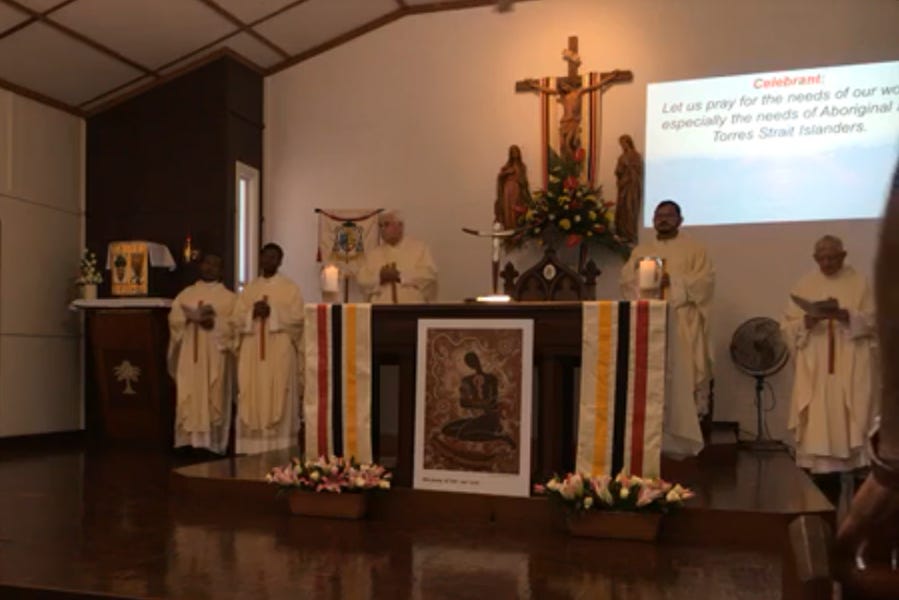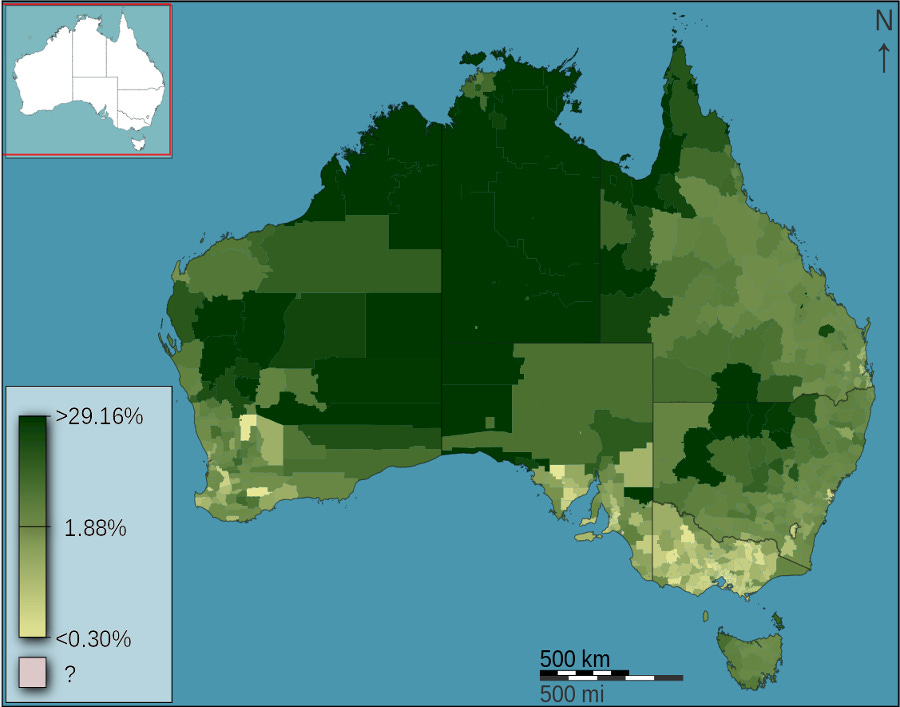
Australia’s bishops endorsed an Aboriginal liturgy. What’s that?
Bishops approve the 'Mass of the Land of the Holy Spirit.'
Australia’s bishops formally approved the use of an Aboriginal liturgy Tuesday during a plenary meeting in Sydney.

They endorsed the liturgy — known as the Mass of the Land of the Holy Spirit, or Missa Terra Spiritus Sancti in Latin — for use in the Diocese of Broome, which covers around 30,000 square miles in the state of Western Australia and serves a Catholic population of around 15,000 people.
Who is the liturgy for? What are its origins? And are there any parallels?
The Pillar takes a look.

Who is the liturgy for?
The Mass of the Land of the Holy Spirit is intended for use in communities of Indigenous Australians, principally in the Broome diocese.
Indigenous Australians are composed of two distinct ethnic groups: Aboriginal Australians, who are based on the mainland and offshore islands, and Torres Strait Islanders, the Indigenous peoples of the Torres Strait Islands, an archipelago located between Australia’s Queensland state and Papua New Guinea.
There were 798,400 Aboriginal and Torres Strait Islander people in Australia in 2016, accounting for 3.3% of the total population. That figure is projected to rise to a million between 2027 and 2029.
According to the National Aboriginal and Torres Strait Islander Catholic Council (NATSICC), there were 133,540 Aboriginal and Torres Strait Islander Catholics in 2016, representing roughly 17% of the total Aboriginal and Torres Strait Islander population.
The number of Aboriginal and Torres Strait Islander Catholics grew at an impressive rate between 1986 and 2016, rising from 46,405 to 133,540 — an increase of 188%.
In the five years from 2011 to 2016 alone, the number rose from 124,625 to 133,540, a gain of 7%.
NATSICC describes Aboriginal and Torres Strait Islander Catholics as the “youngest and fastest growing demographic in the Australian Catholic Church today.”
What are the liturgy’s origins?
The Mass of the Land of the Holy Spirit is the work of many hands, but most accounts of its origins highlight the role of Fr. Kevin McKelson, a Pallottine priest who was posted to Bidyadanga, home to Western Australia’s largest Aboriginal community, in the early 1960s.
McKelson began to learn five languages spoken by local tribal groups: Garadjari, Nyangumarta, Yulparija, Djuwarliny, and Mangarla.
With the help of Aboriginal elders, the priest translated the English version of the Roman Rite of Mass into the five languages, with the support of Broome’s then Bishop John Jobst.
McKelson found that certain terms and phrases used in the Roman liturgy had no direct equivalents in the languages.
“His solution was to take the core concepts used in the Roman Rite and recommend a cultural equivalent that could be understood by the local people,” according to a May 7 statement published by the Australian Catholic Bishops’ Conference’s media blog.
“The translated liturgical texts became songs, with each intrinsic part of the Roman Rite being expressed in a way befitting the ancient local cultures.”
What this means in practice can be seen in a video of a Mass of the Land of the Holy Spirit celebrated at Our Lady Queen of Peace Cathedral in Broome in 2018.
The entrance procession was accompanied by the sound of clapsticks and didgeridoos. After the Sign of the Cross, the celebrant read a prayer of blessing over water in a container decorated with Aboriginal symbols.
“Father in heaven,” he said, “this water brings life to all the people of this land. We bless it in your holy name. Let it bring everlasting hope and your presence among us. In the name of the Father and of the Son and of the Holy Spirit.”
At the Penitential Act, the congregation sang a song that repeated the words, “We have done wrong, we are sorry, help us, Father, not to sin again.”
McKelson, who died in 2011, not only translated the Roman Rite of Mass from English into the Aboriginal languages; he also translated them back again into English.
By 1972, there was a fully formed text ready to be presented to the wider Catholic world.
As Fr. Brian McCoy, S.J., explained in a 2023 article, “while the final version was in English, it sought to express a pattern of language expression that would be accepted by many groups where the handing on of an oral tradition was often expressed by word, dance and repetitive chants, accompanied by hand clapping, clapsticks or didgeridoo.”
Feb. 24, 1973, was a seminal day in the history of the Australian Aboriginal liturgy. That day, the U.S. Cardinal Lawrence Shehan — the papal legate to the 40th International Eucharistic Congress in Melbourne — celebrated the first Aboriginal liturgy at the city’s Sidney Myer Music Bowl.
Footage from the event shows Shehan, the Archbishop of Baltimore, seated near an altar decorated with Aboriginal symbols, with dozens of Aborigines standing on a raised platform behind him.
In May 1973, the Diocese of Broome received permission to use the liturgy on an “ad experimentum” (experimental) basis.
The liturgy — known variously as the Missa Bidyadanga, Missa Indigena, and Missa Kimberley (after Western Australia’s Kimberley region) — continued to be refined in the following years.
In 2018, the text of the Mass was published by Liturgy Brisbane. It was titled the “Mass of the Land of the Holy Spirit,” seemingly in reference to a phrase used by the Portuguese explorer Pedro Fernandes de Queirós, who went in search of the “terra australis incognita” (“unknown southern land”). After discovering what he believed to be the territory in 1606, he named it the “Tierra Australia del Espíritu Santo” (Southern Land of the Holy Spirit).
Although the text of the Mass of the Land of the Holy Spirit is in English, it has also been translated into Aboriginal languages. The version published in 2018 was intended for use in the Diocese of Broome, as well as in other communities, with the agreement of the Bishop of Broome and the local bishop.
The Aboriginal liturgy appeared to receive a significant boost at Australia’s Plenary Council, the country’s most important Catholic event in recent years.
The opening Mass of the Plenary Council’s second assembly, in July 2022, featured an Aboriginal smoking ceremony at the opening Mass of its second assembly.
The Plenary Council issued a decree saying: “Aboriginal and Torres Strait Islander spirituality contains symbols and rituals that, when used appropriately in Catholic liturgical contexts, enrich our celebrations, and facilitate a welcoming environment for Indigenous Peoples.”
Are there any parallels?
Since the liturgical reforms that followed the Vatican Council II, there have been piecemeal efforts around the world to adapt the Roman Rite of Mass to local cultures.
The best-known example may be the Zaire Use of the Roman Rite, which received Vatican approval in 1988 for Catholics in the country known today as the Democratic Republic of the Congo.
Pope Francis celebrated a Mass according to the rite in St. Peter’s Basilica in 2019.
That year, an assembly of the Synod of Bishops in Rome proposed “the elaboration of an Amazonian rite that expresses the liturgical, theological, disciplinary and spiritual patrimony of the Amazon.”
A delegation from the Ecclesial Conference of the Amazon (CEAMA) presented its work on the development of an Amazonian rite to the Vatican’s Dicastery for Divine Worship in September 2022.
In 2023, the Mexican bishops’ conference submitted a proposal to the Vatican for “Indigenous liturgical adaptations,” dubbed the “Mayan rite” in Catholic media coverage.
But Cardinal Felipe Arizmendi explained that it was “not a question of creating a new Indigenous rite but of incorporating into the liturgy various ways of relating to God of these peoples and which express the same thing as the Roman Rite, but in its cultural form.”
In New Zealand, meanwhile, Mass is celebrated in some parishes in te reo Māori, the language of the country’s Indigenous Māori people.
In 2017, Mass was celebrated for the first time in te reo Māori at the Diocese of Hamilton’s Cathedral of the Blessed Virgin Mary. The principal celebrant was Bishop Stephen Lowe, now the Bishop of Auckland.
The movement to adapt the liturgy is therefore taking different forms in the Latin Church, from the creation of new “rites” (strictly speaking, liturgical uses of the Roman Rite), to the introduction of “adaptations,” to translations of the Roman Rite of Mass into Indigenous languages.
The text of the Mass of the Land of the Holy Spirit will now be submitted to the Vatican’s Dicastery for Divine Worship for recognitio (official recognition).
Rome’s recognition may not necessarily lead to a huge upsurge in the use of the Missa Terra Spiritus Sancti, but it’s likely to be a symbolically significant moment.
It would represent a posthumous blessing of the labors of Fr. McKelson and others who worked alongside him.
It might also help to consolidate the identity of Aboriginal and Torres Strait Islander Catholics, who despite their relatively small numbers are a rising force within Australian Catholicism.









I have thoughts. I think Vatican II promoting liturgical inculturation and emphasis on the rights and responsibilities of the local Bishop was a wise decision especially given how quickly interconnected the world became. Problem is the implementation is wonky: if America or France wants more pre-1970's liturgical practices that's creating divisions in the Church, but if Mexico wants to introduce changes to the liturgy for certain populations it's a mature fruit of Vatican II.
Until the Holy See can pick a lane it's hard to not be skeptical of these efforts.
Though on the other hand, as the world becomes more interconnected it's becoming more homogeneous. The video looks cringe to me because the congregation looks like it could be taken from any local American college population. Is the Roman Missal really so unintelligible to people in these cultures that they require more radical changes like this? Videos of the Zaire use are less cringe because very clearly everyone in the room is of a particular culture.
I desperately want to think that an approved liturgy like this was properly formed and represents an organic development of an authentic tradition into an inculturated style of worship.
One can’t help but have the feeling, however, that it’s actually a case of white progressives hijacking the trappings of an indigenous folk tradition to concoct a slapdash mishmash of softly heterodox musings and aesthetic novelties posing as a serious liturgy. It’s doubly upsetting, because on the one hand, it’s a way for “reformers” to impose their values on the communities they serve as well as the Church at large, while simultaneously devaluing indigenous peoples and their intellectual capacity (“oh these aboriginal Australians couldn’t possibly find a way to express something like ‘lift up your hearts’ in their language so we simply must say ‘let us raise the cry of our drums,’” or whatever).
Frankly I wish that more orthodox faithful church leaders would, in fact, devote some time and effort to figuring out how to adequately reform the Roman Rite to certain local customs and cultural expressions. I suspect that there’s a genuine thirst for that among people from indigenous cultures, and that those cultures do have spiritual and philosophical values, not to mention artistic and musical expressions, that can be brought into consonance with Catholic theology.
But unfortunately the only people ever invested in these types of projects seem to be misguided (or, worse, actively ill-intentioned). I can’t pretend to be remotely knowledgeable about this specific Australian liturgy, so I hope I’m wrong, but experience and the few clips and texts I’ve seen don’t inspire much confidence.
It’s worth noting, as well, that Europeans have a centuries old “indigenous” expression of Catholic liturgy that has been specifically denigrated and suppressed while these innovative liturgies are promoted. One has to wonder why.